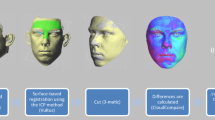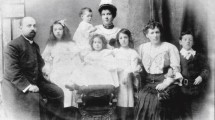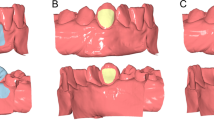Key Points
-
Highlights that stereopsis (three-dimensional vision) is the highest form of depth perception obtained by visual disparity of images formed in the retinas of two eyes.
-
Reports that stereopsis confers functional benefits on everyday tasks such as hand-eye coordination, although its main role is in depth perception and reviews its importance in dentistry.
Abstract
Clinical dental work is placing increasing demands on a clinician's vision as new techniques that require fine detail become more common. High hand-eye coordination requires good visual acuity as well as other psychological and neurological qualities such as stereopsis. Stereopsis (three-dimensional vision) is the highest form of depth perception obtained by visual disparity of images formed in the retinas of two eyes. It is believed to confer functional benefits on everyday tasks such as hand-eye coordination. Although its role in depth perception has long been established, little is known regarding the importance of stereopsis in dentistry. This article reviews the role of stereopsis in everyday life and the available literature on the importance of stereopsis in dentistry.
Similar content being viewed by others
Introduction
Dentistry is one of the most visually demanding professions. Dentists are required to accurately judge shapes, contours, proportions, colour, symmetry, distances and depth. Depth judgement is particularly crucial for cavity preparation. Besides using manual depth cues (such as probes), the brain can use several visual mechanisms to judge the depths of cavities including: perception of size, shadow, motion parallax (achieved by slight movement of the observer's head), and stereopsis (three-dimensional vision). Stereopsis is the highest form of depth perception and relies on the ability to fuse the separate retinal images from each eye into one image. The eyes are horizontally separated in the head and each eye sends a slightly different image to the brain. The fusion of these two images permits estimation of depth. Stereopsis therefore requires good vision in both eyes. Stereopsis is routinely measured by one of several simple clinic tests, and the quantitative result is termed stereoacuity (measured in seconds of arc). While it is agreed that depth perception in general is necessary for dentistry,1,2 it is not established if stereopsis is essential, or whether other depth perception mechanisms can suffice if stereopsis is deficient.
The aim of this paper is to review all published literature looking at the role of stereopsis in dentistry. The objective of this review is to assess if stereopsis is required in dentistry based on the current literature.
Literature review method
We searched the Medline database of the National Library of Medicine and Cochrane library to identify any published articles that contain:
-
'stereopsis/3 dimensional vision' and 'dentistry'
-
'stereopsis/3 dimensional vision' and 'dental students'
-
'stereopsis/3 dimensional vision' and 'dental practice'
-
'stereopsis/3 dimensional vision' and 'dentists'
Six relevant articles were identified and were all reviewed by the two authors. All the papers were included for review. The identified articles were correlated with published literature on the relation of stereopsis and motor skill performance.
Judgement of depth
The relationship between motor skill performance and stereoacuity has been well documented in the ophthalmic literature.3,4 There is a considerable body of evidence suggesting that stereopsis confers functional benefits in everyday tasks including hand-eye coordination. Several studies have demonstrated that subjects with normal stereoacuity completed practical tasks (eg bead threading, moving pegs in and out of a board) faster or with fewer movements than participants with reduced stereoacuity.5,7 Similarly, normal binocular stereovision is essential for accurate grasping of both moving and stationary targets.4 Furthermore, children with amblyopia (lazy eye) and hence abnormal stereopsis, have reduced speed and accuracy of movements compared to their peers.8 The reduction in the speed and accuracy of movements showed a more consistent relationship with the reduction in stereopsis rather than the accompanying depth of amblyopia. Adults with amblyopia exhibit hesitancies and errors in the final reach and grasping phases of the movements relating to the level of stereoacuity similar to amblyopic children.6,9,10 However, amblyopic adults moved faster than amblyopic children. O'Connor and colleagues6 demonstrated that the decrease in performance in stereodeficient individuals increased with increasing task difficulty.
The same study also showed some adaptation to long term absence of stereoacuity. Subjects with no stereoacuity were quicker in threading beads compared to subjects with normal stereoacuity who were temporarily rendered stereoblind by monocular occlusion. To our knowledge this is the only reported evidence of enhanced real world visuomotor function in stereodeficient subjects. The above study implies that children with amblyopia and defects in stereoacuity can improve their hand-eye coordination skills with practice. Increased action planning through repeated sensory and motor experience may explain the increased performance as the motor skills mature. In agreement with this suggestion, Melmoth11 noticed prolonged contact time with objects and adjustment in grip before stereodeficient individuals pick objects compared to controls.
Stereopsis in dentistry
Stereopsis in dental training
Stereopsis has always been seen as essential for dental training as hand-eye coordination is required for depth perception during cavity preparation.12 There are three studies available in the literature where this assumption was challenged by assessing stereopsis in dental students. Ireland13 was the first who tested corrected visual acuity using Snellen chart and stereopsis using the TNO test in all the students entering the Luisiana State Univestity School of Dentistry (n = 93). He then followed all dental students in practical examinations and correlated performance in these practical assessments with stereopsis. He found no statistically significant difference between the stereoacuity and student grades. In another study Rowlinson14 screened dental undergraduates entering the University of Sheffield (n = 46) for visual problems so students could get any treatment available at an early stage in their career. The stereopsis was assessed using the TNO and Wirt/Titmus stereoacuity tests. The TNO test identified four students with no stereopsis while only one stereodeficient student was identified via the Wirt/Titmus test. The screening of the enrolling dental students continued over seven years. In total he identified ten out of 235 dental students with no stereopsis using the TNO test. He followed those for seven years.15 He did not identify any significant obstacle to their development of practical skills important in dentistry. Early identification of these individuals with incomplete stereopsis may have facilitated their education on how to compensate using other visual cues, such as distribution of shadows and overlay of contours.
In a more recent study, Dimitrijevic and colleagues16 found no statistical relationship between stereopsis (using the TNO test) and depth estimation in 163 dentistry students and 20 experienced dentists. In this study students were grouped together according to the year of training. Interestingly, students with no experience in preclinical operative dentistry performed significantly worse in depth estimation than dentistry students and experienced dentists. In addition, there was no statistical difference between the performance of students and experienced dentists. A limitation of this study is that particpants were volunteers, and it is possible that students with known visual problems may have elected not to participate.
Following review of the literature on stereopsis in dentistry students, we conclude that contrary to the generally-held assumption, stereopsis has not been found to correlate with performance in practical assessments, longer-term acquisition of practical skills or even in judgement of depth in dental students.
Stereopsis in experienced dentists
Our literature search identified only one publication to date assessing stereopsis in practising dentists. Forgie and colleagues17 invited dentists practising in Scotland to participate in the study. A total of 46 clinicians volunteered to participate in the study. Data was collected on stereopsis, muscle balance, visual acuity and contrast sensitivity. Stereopsis was assessed using the TNO test. The results showed that the stereopsis followed a Gaussian distribution ranging from poor (480 seconds of arc) to good (15 seconds of arc). The study identified three out of the 46 practising dentists (10% of participants) with no stereopsis measured using the TNO test. Although this study is limited by the small sample size, it is in agreement with the studies performed in dental students, and suggests that deficiency in stereopsis is not a hindrance to career progression in dentistry.
Summary
Stereoacuity is considered as a benchmark test for peak clinical fine motor performance of binocular vision. Good depth perception has been described as necessary requirement for the practice of dentistry.1,2 The limited published literature regarding strereoacuity in dentistry does not support the above, although the studies are not without their flaws. Krol18 was the first one to appreciate that depth perception using a stereotest is different than viewing a real three-dimensional image. In a stereogram the perceived objects appear to move in space if the observer changes his viewing position relative to the stereotest. In addition, the TNO stereoacuity test used to assess stereovision in all the published studies eliminates monocular cues with the use of red-green spectacles. Monoclar cues are present in real life and may explain why some practising dentists with deficient stereopsis exist.
The current published literature on stereopsis in dentistry has two important limitations. Most of the studies have small sample sizes and the study assessing stereopsis in practising dentists relied on volunteers. Further larger studies are required to assess stereopsis and clinical performance in dentistry to confidently conclude that stereopsis is not essential in dentistry. Stereoacuity should be tested in all the students entering dentistry and performance should be retested at regular intervals along university. In addition, it would be of benefit to identify any stereodeficient dental students early in their training so they can learn to use monocular cues and other strategies to achieve three-dimensional vision. In the meantime, until further literature becomes available, stereopsis should not be considered a requirement for dental training.
Conclusion
There is no robust evidence to support the requirement of stereopsis in dentistry; however, there are currently a limited number of published literature papers on the topic. Further studies with larger numbers of participants are required to validate the current evidence.
References
Chadwick R G . Factors influencing dental students to attend for eye examination. J Oral Rehabil 1999; 26: 72–74.
Leach C D . Staining technique for teaching preparations depth in natural teeth. J Den Edu 1983; 47: 626–628.
Joy S, Davis H, Buckley D . Is stereopsis linked to hand eye coordination? Br Orthop J 2001; 58: 38–41.
Melmoth D R, Grant S . Advantages of binocular vision for the control of reaching and grasping. Exp Brain Res 2006; 171: 371–388.
Hrisos S, Clarke M P, Kelly T, Henderson J, Wright C M . Unilateral visual impairment and neurodevelopmental performance in preschool children. Br J Ophthalmol 2006; 90: 836–838.
O'Connor A R, Birch E E, Anderson S, Draper H, FSOS Research Group. The functional significance of stereopsis. Invest Ophthalmol Vis Sci 2010; 51: 2019–2023.
Webber A L, Wood J M, Gole G A, Brown B . The effect of amblyopia on fine motor skills in children. Invest Ophthalmol Vis Sci 2008; 49: 594–603.
Suttle C M, Melmoth D R, Finlay A L, Sloper J J, Grant S . Eye-hand coordination skills in children with and without amblyopia. Invest Ophthalmol Vis Sci 2011; 52: 1851–1864.
Lenoir M, Musch E, La Grange N . Ecological relevance of stereopsis in one-handed ball-catching. Percept Mot Skills 1999; 89: 495–508.
Mazyn L I, Lenoir M, Montagne G, Savelsbergh G J . The contribution of stereo vision to one-handed catching. Exp Brain Res 2004; 157: 383–390.
Melmoth D R, Finlay A L, Morgan M J, Grant S . Grasping deficits and adaptations in adults with stereo vision losses. Invest Ophthalmol Vis Sci 2009; 50: 3711–3720.
Holliday H, Koephen E E . Visual tasks as a criterion in the selection of dental students. J Dent Educ 1954; 18: 7–17.
Ireland E J, Ripps A H, Morgan K S . Stereoscopic vision and psychomotor learning in dental students. J Dent Educ 1982; 46: 697–698.
Rowlinson A . A study to investigate the visual quality of dental undergraduates using a simple screening programme. Aust Dent J 1988; 33: 303–307.
Rowlinson A . A simple eyesight screening program for dental undergraduates; results after 7 years. Aust Dent J 1993; 38: 394–399.
Dimitrijevic T, Kahler B, Evans G, Collins M, Moule A . Depth and distance perception of dentists and dental students. Oper Dent 2011; 36: 467–477.
Forgie A H, Gearie T, Pine C M, Pitts N B . Visual standards in a sample of dentists working within Scotland. Prim Dent Care 2001; 8: 124–127.
Krol J D . Perceptual ghosts in stereopsis - a ghostly problem in binocular vision. Amsterdam: Rodopi, 1982.
Author information
Authors and Affiliations
Corresponding author
Additional information
Refereed Paper
Rights and permissions
About this article
Cite this article
Syrimi, M., Ali, N. The role of stereopsis (three-dimensional vision) in dentistry: review of the current literature. Br Dent J 218, 597–598 (2015). https://doi.org/10.1038/sj.bdj.2015.387
Accepted:
Published:
Issue Date:
DOI: https://doi.org/10.1038/sj.bdj.2015.387
This article is cited by
-
Dressmakers show enhanced stereoscopic vision
Scientific Reports (2017)
-
In surgery: An observation on an observation
British Dental Journal (2015)
-
A three dimensional view of stereopsis in dentistry
British Dental Journal (2015)
-
Stereopsis in dentistry: Dismal sporting skills
British Dental Journal (2015)



